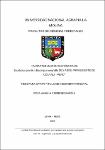Mostrar el registro sencillo del ítem
Caracterización anatómica de Eucalyptus grandis x Eucalyptus urophylla de 5 años, proveniente de Ucayali – Perú
| dc.contributor.advisor | Chavesta Custodio, Manuel | |
| dc.contributor.author | Céspedes García, Rosa Amelia | |
| dc.date.accessioned | 2023-12-11T20:54:39Z | |
| dc.date.available | 2023-12-11T20:54:39Z | |
| dc.date.issued | 2023 | |
| dc.identifier.uri | https://hdl.handle.net/20.500.12996/6098 | |
| dc.description | Universidad Nacional Agraria La Molina. Facultad de Ciencias Forestales. Departamento Académico de Industrias Forestales | es_PE |
| dc.description.abstract | La investigación tuvo como finalidad la caracterización anatómica de la madera de Eucalyptus grandis x Eucalyptus urophylla según los lineamientos establecidos por la International Association of Wood Anatomists - IAWA (1989) y del Instituto Brasileiro do Meio Ambiente e dos Recursos Naturais Renováveis IBAMA (1991). Se evaluó la madera de cinco árboles de 5 5 años provenientes de Coronel Portillo, en tres posiciones longitudinales y tres posiciones radiales; asi como de su interacción. La madera presenta grano entrecruzado y textura media; poros solitarios, de forma ovalada y en arreglo diagonal; parénquima paratraqueal vasicéntrico y radios no estratificados. Microscópicamente los radios son homocelulares conformados por células procumbentes, uniseriados; las fibras son libriformes no estratificadas. No se encontró diferencias en las características cualitativas, pero sí en las características cuantitativas de los elementos anatómicos. Axialmente, la longitud de fibras no muestra un crecimiento definido; el diámetro tangencial de poros mantiene su crecimiento hasta el nivel intermedio para luego aumentar; la longitud de fibras aumenta hacia el intermedio para luego mantenerse y el diámetro de fibras mantiene su crecimiento hasta el intermedio para luego disminuir al ápice y el espesor de pared no presenta diferencias en su comportamiento. Radialmente la longitud de vasos no muestra crecimiento definido; el diámetro tangencial de poros mantiene su crecimiento hasta el nivel medio para luego aumentar hacia la corteza; la longitud de fibras aumenta de médulacorteza; el diámetro de fibras no presenta diferencias significativas y el espesor de pared aumenta médula-corteza. Los coeficientes de variabilidad más homogéneos se encontraron en el espesor de pared, la longitud y diámetro de fibras, en el orden de más a menos respectivamente. | es_PE |
| dc.description.abstract | The research aimed to characterize the anatomy according to the guidelines established by the International Association of Wood Anatomists - IAWA (1989) and the Brazilian Institute of Environment and Renewable Natural Resources - IBAMA (1991). The wood of 5 year old Eucalyptus grandis x Eucalyptus urophylla trees from Coronel Portillo was evaluated in three longitudinal positions and three radial positions. The anatomical elements, their behavior at the axial and radial levels, and their interaction were assessed. The wood exhibits interlocked grain and medium texture. It has solitary pores, oval-shaped and arranged diagonally; vasicentric paratracheal parenchyma and non-stratified rays. Microscopically, the wood shows unilateral vasicentric paratracheal parenchyma, homocellular rays consisting exclusively of procumbent, uniseriate cells, and non-stratified libriform fibers. There are no differences in the qualitative characteristics, but there are differences in the quantitative characteristics of the anatomical elements between the longitudinal and radial interactions. Axially, the fiber length does not show a defined growth; the tangential pore diameter maintains its growth until the intermediate level and then increases; the fiber length increases towards the intermediate level and then remains constant; the fiber diameter continues to grow until the intermediate level and then decreases towards the apex, while the wall thickness does not show differences in its behavior. Radially, the vessel length does not show a defined growth; the tangential pore diameter maintains its growth until the middle level and then increases towards the bark; the fiber length increases from pith to bark; the fiber diameter does not show significant differences, and the wall thickness increases from pith to bark. The most homogeneous coefficient of variation was found in fiber wall thickness, fiber length, and fiber diameter. | es_PE |
| dc.format | application/pdf | es_PE |
| dc.language.iso | spa | es_PE |
| dc.publisher | Universidad Nacional Agraria La Molina | es_PE |
| dc.rights | info:eu-repo/semantics/openAccess | es_PE |
| dc.rights.uri | https://creativecommons.org/licenses/by-nc-nd/4.0/ | es_PE |
| dc.subject | Anatomía de la madera | es_PE |
| dc.title | Caracterización anatómica de Eucalyptus grandis x Eucalyptus urophylla de 5 años, proveniente de Ucayali – Perú | es_PE |
| dc.type | info:eu-repo/semantics/bachelorThesis | es_PE |
| thesis.degree.discipline | Ciencias Forestales | es_PE |
| thesis.degree.grantor | Universidad Nacional Agraria La Molina. Facultad de Ciencias Forestales | es_PE |
| thesis.degree.name | Ingeniero Forestal | es_PE |
| dc.subject.ocde | pendiente | es_PE |
| renati.author.dni | 72736984 | es_PE |
| dc.publisher.country | PE | es_PE |
| dc.type.version | info:eu-repo/semantics/publishedVersion | es_PE |
| renati.advisor.orcid | https://orcid.org/0000-0002-5774-6159 | es_PE |
| renati.advisor.dni | 07378293 | es_PE |
| renati.type | https://purl.org/pe-repo/renati/type#tesis | es_PE |
| renati.level | https://purl.org/pe-repo/renati/level#tituloProfesional | es_PE |
| renati.discipline | 821016 | es_PE |
| renati.juror | Meléndez Cárdenas, Miguel Ángel | |
| renati.juror | Reynel Rodríguez, Carlos Augusto | |
| renati.juror | Montenegro Muro, Rolando Antonio |
Ficheros en el ítem
Este ítem aparece en la(s) siguiente(s) colección(ones)
-
CFO-IF Tesis [167]





